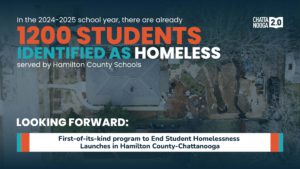New Hamilton County Schools Superintendent Bryan Johnson answered questions and shared his vision for the Hamilton County Department of Education with parents and community members during a welcome reception at the Bessie Smith Cultural Center on Tuesday, August 8th.
Once Johnson finished talking about his plans for the future of the district, he turned to answer questions. Parents and community members wrote their questions on index cards for Johnson to answer.
You can read more from the Times Free Press’s coverage of the welcome reception here.
Below are the full set of questions and answers that Dr. Johnson did not have time to address that evening:
Q1: How can HCDE level the playing field for students with physical disabilities and mobility impairments and how will you support success for students with disabilities?
A: Our goal is that all HCDE students have access to individualized learning and a high-quality education. Every school will ensure that we are meeting students where they are and providing necessary resources so that every student can reach his or her full potential. It will be my job as Superintendent to ensure we are making budgetary considerations and equitable access to interventions and programs designed to help students reach appropriate benchmarks and accountability of all schools.
Q2: Exceptional Education is not uniform throughout the school system. My son was next to last in his graduating class and earned a 3.75 GPA his 1st year in college. That’s a problem! What do you propose to help dyslexic children specifically, and children with learning differences in general?
A: Using GPA or class rank alone to determine student success is not the best indicator for comparison to college success. GPA only reflects a student’s performance on school assignments and assessments. ACT, attendance, student discipline and engagement in extra-curricular activities are also other indicators that should be considered when determining student success. The ACT has a set of benchmarks (college ready indicator scores) that reflect a student’s likelihood of scoring a B, C, or higher in a college credit-bearing course. Because every student has a different set of circumstances, the overall academic history and trends of an individual student need to be analyzed to answer this question. I will say that academic standards in the State of TN over the last two years have a much higher proficiency threshold and are now on pace with National standards of achievement. It would seem if this student is doing great in college, he mastered standards taught in school and was well prepared for his journey in college.
Q3: What will you do to lower the pupil teacher ratio in each grade?
A: The State of TN sets a maximum class per pupil ratio (based on grade levels) that we must follow. In the areas where we are not compliant, we will work with building principals to address these issues urgently. Student growth also plays a role in classes being at or over capacity, so we must ensure from a leadership standpoint that we are making accurate projections for growth. Once we can no longer sustain required class sizes in a building, we will work with the county to plan for schools or consider rezoning, whichever option is the most fiscally responsible.
Q4: How can we have a complete curriculum in every school that includes opportunities in every art form? What are your thoughts on arts integration and teacher practice?
A: STEM is one way to integrate arts and something we will begin to study. We will also work with principals to consider school budgets, current course offerings, and student interests to ensure that we align and offer more of the arts at each school. Adding more courses or programs may also mean that those students would be coming out of other classes or programs and each school community should determine what will the most valuable experience for their student populations. Every community is different but the arts are important to student development. Another option is to work with the community to offer “the arts” before and after school through clubs and other program partnerships. Grant funds could also be available to assist HCDE in expanding the arts, so we will also be looking at those options.
Q5: What is your plan for failing schools in District 9?
A: We are working with the State Department of Education to create a partnership. The school board approved a plan on August 17th, the “Opportunity Zone” which will create a more sustainable infrastructure and targeted services dedicated to the whole-child of all schools in the district that will include community schools’ coordinators, data coaches, and other services. There will be an HCDE Chief overseeing these 12 schools specifically.
Q6: Are you willing to study the plans developed by the two different business groups and make hard choices that would be necessary to streamline the system?
A: Yes, and this is already in progress. I have met with dozens of business leaders and non-profit leaders focused on school improvement and we will work together to improve schools.
Q7: Where are your children going to go to school?
A: Both children will attend zoned public schools in the neighborhood in which we live.
Q8: How will you address any leader in the main office who says that a disabled child costs too much to educate and they will not educate him?
A: I believe that all students can learn and grow. It is a moral imperative for children to receive a high quality public education and my team will not tolerate anyone who refuses to offer services that are required of us as a public-school system.
Q9: Are you going to provide culture competency training to HCDE staff?
A: We will implement a leadership framework across the district that includes self-awareness and other practices that have proven to be effective in shaping a positive culture at all levels of the district.
Q10: How will you address the problem of school and community organization partnerships?
A: I am not sure what specific issues are referenced here; however, I will work with the community to ensure that we are making the best use of all available partnership assets and that the efforts align with our vision and district goals. Partnerships should be two-way with clear objectives for each party. Hamilton County is blessed to have an impressive number of community members, businesses and other organizations volunteering with our schools and district office.
Q11: How will you address transportation for after school activities like tutoring?
A: We will continue to look at funding streams to support after school activities. We realize these activities are important.
Q12: When will arts be a part of related arts in our schools?
A: This is something that is important to me as a parent and important to this community. We will work diligently this year to see how we may expand offerings and access to all students to experience the arts. Also see Q5 & Q14.
Q13: Are you willing to train staff on restorative justice and address discipline inequities?
A: We will continue to explore restorative justice practices. Several of our schools have been trained on restorative practices.
Q14: What are your plans for improving bus safety?
A: We understand that providing safe transportation is important. The board improved some contract language in the late spring and we will continue to monitor bus safety very closely.
Q15: Why does the education system here focus so much on test scores and students are not being taught to write a simple letter, a mailing envelope, and a check?
A: We recognize that these skills are important. We value the development of these skills, but also know that students must master the state standards. We will continue to work on the development of these skills that are invaluable for life.
Q16: What can and will you do about more financial funding for schools since Title I funding has been removed and cut from schools system-wide?
A: We will continue to work with the County Commission and the County Mayor to identify ways to support school funding.
Q17: How familiar are you with arts integration, and are you interested in supporting teacher’s collaboration in this area?
A: See Q5 & 14 and yes, I am interested in seeing educators collaborate more in the areas of arts integration. Many times, this is done through STEM or STEAM.





